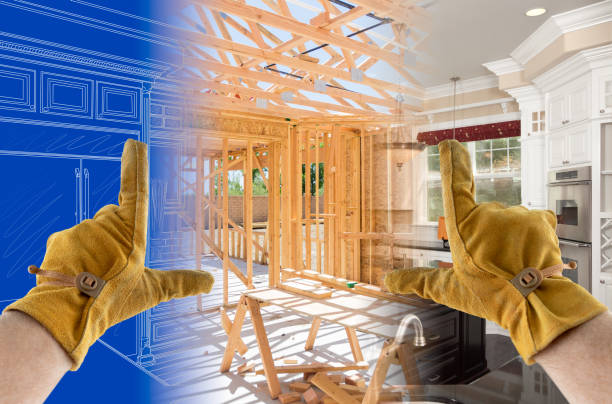Home renovation opens up endless possibilities, enhancing your living space and property value. This guide is designed for both DIY enthusiasts and newcomers, offering a comprehensive roadmap for transforming homes. It covers planning, budgeting, eco-friendly materials, and smart technology.
Setting the Stage for Home Renovation
Every successful home renovation begins with a vision. Perhaps you’ve been dreaming of an open-concept kitchen or a serene master bath that transports you to a spa-like retreat. Whatever your inspiration, it’s crucial to articulate your goals clearly. Knowing what you want helps streamline the process and prevents costly missteps.
For some, the motivation to renovate stems from a desire to increase their home’s market value. Others may wish to enhance functionality or update outdated elements. Regardless of your reasons, recognizing these motivations will guide your decisions throughout the project.
Finally, consider the potential challenges you might face during your renovation. From unexpected structural issues to budget constraints, addressing these factors early on will equip you with the resilience needed to see your project through to completion.
The Planning Phase: Research and Inspiration
Research is the backbone of any successful renovation project. Begin by immersing yourself in design magazines, online platforms like Pinterest, and home improvement shows. This will help you gather ideas and discover styles that resonate with you.
Take time to understand the architectural elements of your home. Identifying its strengths and weaknesses can help you decide which areas require the most attention. It also ensures that any changes remain in harmony with the overall design.
Once you’ve gathered ample inspiration, create a mood board to visualize your ideas. This tool will serve as your creative compass, helping you communicate your vision to architects, designers, and contractors.
Budgeting Tips: Maximizing Your Renovation Dollars
A well-planned budget is essential to avoid the dreaded financial surprise. Start by determining how much you’re willing to invest in the project. Prioritize key areas where spending will have the most significant impact, like kitchens and bathrooms, which typically offer a good return on investment.
Research the costs associated with each aspect of your renovation. Factor in materials, labor, permits, and unexpected expenses. This will give you a realistic picture of what your project may cost and help you allocate funds accordingly.
Consider exploring financing options such as home equity loans, lines of credit, or personal savings. Each option comes with its own set of pros and cons, so it’s crucial to choose one that aligns with your financial goals.
Hiring the Right Professionals: Navigating the Market
Finding the right professionals to bring your vision to life is crucial. Start by seeking recommendations from friends, family, or online reviews. If you’re looking for interior design like those available in Highland, verify each candidate’s credentials, past projects, and client testimonials to ensure they meet your standards.
Conduct interviews with potential contractors or designers. Discuss their approach to projects, timelines, and communication styles. A good rapport and a clear understanding of your expectations will lead to a smoother collaboration.
Finally, obtain detailed estimates from multiple professionals. Compare these to find a balance between quality and cost. Remember, the cheapest option isn’t always the best. Investing in experienced professionals can save you money and stress in the long run.
The Renovation Process: Step-by-Step Guide
Once your team is assembled, it’s time to kick off the renovation process. It typically begins with demolition, removing any unwanted structures or materials to make way for new additions. This phase requires careful planning to avoid damaging the existing structure.
Construction follows, where walls are built, floors are laid, and fixtures are installed. Regular communication with your contractor will ensure the project remains on track and aligns with your vision.
Finishing touches come next, bringing personality and style to your home. This includes painting, adding trim, and installing lighting and hardware. Pay attention to details, as they can elevate the overall look and feel of your space.
Sustainable Renovations: Eco-Friendly Options
Incorporating sustainable practices into your renovation can reduce your carbon footprint and enhance your home’s environmental performance. Consider using recycled or reclaimed materials for flooring and countertops, which add character while conserving resources.
Energy-efficient appliances and fixtures also play a vital role in sustainability. They lower utility bills and reduce greenhouse gas emissions, making them a wise long-term investment.
Finally, explore renewable energy options like solar panels or geothermal heating. These technologies can significantly cut energy costs and demonstrate a commitment to environmental stewardship.
Technology in Renovation: Smart Homes and Apps
Smart home technology has revolutionized the way we live. Integrate features like programmable thermostats, automated lighting, and security systems for added convenience and peace of mind.
Apps dedicated to home renovation and design can assist you throughout the process. Use them to track budgets, create floor plans, and visualize color schemes. They offer a modern approach to project management, keeping everything at your fingertips.
Incorporating these technologies can enhance your home’s functionality and add a layer of sophistication that appeals to tech-savvy buyers if you decide to sell.
Final Touches: Making Your House a Home
With the heavy lifting done, it’s time to add personal touches that reflect your style and personality. Consider mixing textures and colors to create a warm, inviting atmosphere. Artworks, rugs, and textiles are excellent ways to infuse character into your space.
Don’t overlook the importance of lighting, which can dramatically alter a room’s mood. Layer different types of lighting—ambient, task, and accent—to create depth and dimension.
Lastly, incorporate greenery and natural elements. Plants purify the air and bring a sense of tranquility to your home, enhancing both aesthetic appeal and well-being.
Conclusion
Now that you have a better understanding of the renovation process, it’s time to put your plan into action. Remember to stay organized, communicate clearly with your team, and make decisions that align with your vision and budget. And most importantly, enjoy the journey of transforming your house into a home.

